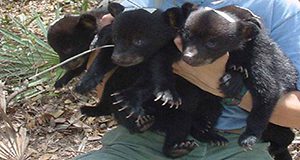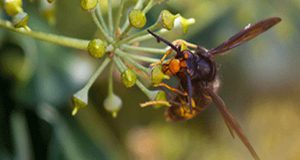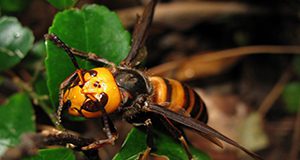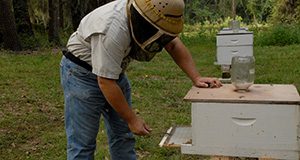The American black bear is beloved, but it is also the most damaging vertebrate pest of honey bee apiaries in North America. That is in part because bears and beekeepers often share the same home territory. Many top beekeeping and pollination states also fall within the range of the American black bear. Can bears and beekeepers live in peace together? This 6-page fact sheet written by Kimberly K. Post and Cameron Jack and published by the UF/IFAS Entomology and Nematology Department details the basic steps for installing an electrified bear fence around a bee yard so that savvy beekeepers can protect hives and honey without harming honey-loving bears.
https://edis.ifas.ufl.edu/in1318
Tag: Cameron Jack
Yellow-Legged Hornet (suggested common name), Vespa velutina (Lepeletier 1836) (Insecta: Hymenoptera: Vespidae)
The yellow-legged hornet, Vespa velutina (Lepeletier), is a pest of concern outside of its native range. Vespa velutina is native to Southeast Asia and has invaded several regions in Europe, first appearing in France in 2004. As a generalist predator, they are a pest of honey bees and a major concern to many beekeepers. Vespa velutina has not been intercepted in North America, but it is believed to have high invasion potential. This 5-page fact sheet written by Krystal Ashman, Oliver Keller, and Cameron Jack and published by the UF/IFAS Entomology and Nematology Department describes the hornet and explains its live cycle, biology, and some of its predatory strategies.
https://edis.ifas.ufl.edu/in1282
Asian Giant Hornet, Vespa mandarinia Smith (1852) (Insecta: Hymenoptera: Vespidae)
Vespa mandarinia Smith, commonly called the Asian giant hornet, is the largest hornet in the world. Its size and distinctive markings make it easily distinguishable from other Asian hornet species. Not only is the wasp occasionally life-threatening to humans, it can decimate a number of insect colonies, most notably wild and farmed honey bees. Vespa mandarinia is native to Japan and occurs in several countries in Asia. The first Vespa madarinia hornet detected in the United States was in Washington State in 2019. This 5-page fact sheet written by Caitlin Gill, Cameron Jack, and Andrea Lucky and published by the UF/IFAS Entomology and Nematology Department describes the hornet, its biology, its predatory strategies, and its medical significance. The fact sheet also provides some strategies for management of this dangerous and destructive hornet.
https://edis.ifas.ufl.edu/in1281
How to quantify Varroa destructor in honey bee (Apis mellifera L.) colonies
The Varroa destructor mite, a devastating pest of western honey bees, can threaten a honey bee colony’s survival if it is left uncontrolled. This 8-page fact sheet written by Cameron Jack, Nathan Sperry, Ashley N. Mortensen, and Jamie Ellis and published by the UF/IFAS Entomology and Nematology Department explains how to monitor honey bee colonies to ensure that infestations of these destructive pests do not grow to dangerous levels.
https://edis.ifas.ufl.edu/in1257



